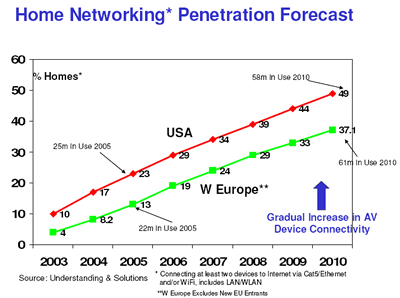 More than 1 in 3 European households will have an integrated home network by 2010, according to a new industry report from Understanding & Solutions.
More than 1 in 3 European households will have an integrated home network by 2010, according to a new industry report from Understanding & Solutions.
Until recently, home networking – the ability to connect digital devices together around the home – has largely been confined to Broadband and PC networking. However, linking multiple computers, telephones, televisions, Personal Video Recorders (PVRs), games consoles, home security systems and other digital devices into a home network is slowly beginning to generate a groundswell of activity.
Understanding & Solutions predicts that within 2-3 years IP crossover networking (bridging the gap between PC/Broadband and AV/Broadcast) will gradually increase as a result of consumer demand, coupled with a growing online content supply from the entertainment, photo services and consumer electronics industries.
“We’re all becoming more demanding, craving access to up-to-the-minute entertainment and information – however, wherever and whenever we want it,” says John Bird, Principal Analyst at Understanding & Solutions. “Home networking is the new gateway that manages, transports and stores our information across multiple devices within the home: it’s the great content enabler and by 2010 at least 30-50% of all consumer electronics devices on sale will be network-enabled.”
There are two key factors driving the home networking revolution, each with its own respective service provider ‘push’: namely, the wide availability of Broadband and the increase of digital multi-room TV networking.

Consumers want to access Web content on a range of devices, including PCs, laptops (accounting for over 50% of the consumer PC market), games consoles and handheld devices. Additionally, PCs are increasingly being used to store entertainment content, which consumers now want to access and view on other consumer electronics products around the home, including TVs, PVRs and home audio equipment.
In parallel with this Broadband-driven trend, multi-room TV networking will move from analogue to the digital domain over the next 3 years, using Wi-Fi and a variety of ‘no new wires’ technologies. For example, coax, powerline and phone line communication signals can now carry a digital network signal around the home: simply plug in and you are connected.
A significant cultural change over recent years is that many consumers are using the PC as a mainstream TV viewing platform. Indeed, a quarter of European homes now have PCs and TVs co-located in the living room.
“Another key factor,” says Bird, “is the MP3 boom. With more than 200 million player owners worldwide, consumer focus is moving towards the PC as a music access device, storage platform and media library. This is resulting in a small, but growing number of users networking PC-based content and direct Broadband connectivity across to other audio devices such as home music systems.”
Networking of AV/Broadcast-centric and PC/Broadband-centric ‘clusters’ will not happen overnight, but the ingredients for market growth are there. As Broadband architectures and mass storage evolve towards fully-networked distribution systems, a new breed of consumer is demanding its own home entertainment and communications hub in a rapidly converging marketplace.